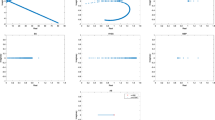Abstract
A novel zero attraction affine projection sign algorithm (ZA-APSA) for strong impulsive and sparse environment is proposed in this paper. Here \(\mathrm{l}_{1}\) norm penalty is introduced to original cost function of APSA which provides zero attraction to the filter weights. The APSA provides lower computational complexity and is robust against impulsive noise, whereas the ZA-APA works well in sparse environment with improved convergence and lower steady-state error. The proposed ZA-APSA combines the feature of APSA and ZA-APA, and hence, it provides faster convergence and lesser steady-state error with high robustness to impulsive interference with low computational complexity than the conventional ones. The stability condition for the convergence in the mean and mean square error sense is derived. Theoretical analysis is made to prove that the proposed algorithm can achieve lesser steady-state mean square error than APSA. Simulations are performed to validate the analysis made and to prove the suitability of the proposed algorithm for sparse and impulsive system identification.







Similar content being viewed by others
References
F. Albu, H.K. Kwan, Memory improved proportionate affine projection sign algorithm. Electron. Lett. 48(20), 1279–1281 (2012)
Y. Chen, Y. Gu, A.O. Hero, Sparse LMS for system identification, in 2009 IEEE International Conference on Acoustics, Speech and Signal Processing 2009, Apr 19. IEEE, pp. 3125–3128
M. Dai, C. WanSung, Achieving high diversity and multiplexing gains in the asynchronous parallel relay network. Trans. Emerg. Telecommun. Technol. 24(2), 232–243 (2013)
B.K. Das, L.A. Azpicueta-Ruiz, M. Chakraborty, J. Arenas-García, A comparative study of two popular families of sparsity-aware adaptive filters, in 2014 4th International Workshop on Cognitive Information Processing (CIP) 2014 May 26. IEEE, pp. 1–6
B.K. Das, M. Chakraborty, Sparse adaptive filtering by an adaptive convex combination of the LMS and the ZA-LMS algorithms. IEEE Trans. Circuits Syst. I Regul. Pap. 61(5), 507–1499 (2014)
E. Hänsler, The hands-free telephone problem—an annotated bibliography. Signal Process. 27(3), 71–259 (1992)
S.S. Haykin, Adaptive Filter Theory (Pearson Education India, Gurgaon, 2008)
S.H. Kim, J.J. Jeong, J.H. Choi, S.W. Kim, Variable step-size affine projection sign algorithm using selective input vectors. Signal Process. 31(115), 6–151 (2015)
V.J. Mathews, S. Cho, Improved convergence analysis of stochastic gradient adaptive filters using the sign algorithm. IEEE Trans. Acoust. Speech Signal Process. 35(4), 4–450 (1987)
R. Meng, R.C. de Lamare, V.H. Nascimento, Sparsity-aware affine projection adaptive algorithms for system identification, in Sensor Signal Processing for Defence (SSPD 2011) 2011 Sep 27. IET, pp. 1–5
R. Meng, Sparsity-Aware Adaptive Filtering Algorithms and Application to System Identification. M.Sc. Research Thesis, University of York (2011)
C. Paleologu, J. Benesty, S. Ciochina, A variable step-size affine projection algorithm designed for acoustic echo cancellation. IEEE Trans. Audio Speech Lang. Process. 16(8), 78–1466 (2008)
C. Paleologu, S. Ciochina, J. Benesty, An efficient proportionate affine projection algorithm for echo cancellation. IEEE Signal Process. Lett. 17(2), 165–168 (2010)
A. Papoulis, S.U. Pillai, Probability, Random variables, and Stochastic Processes (Tata McGraw-Hill Education, New Delhi, 2002)
R. Price, A useful theorem for nonlinear devices having Gaussian inputs. IRE Trans. Inf. Theory 4(2), 69–72 (1958)
J. Radecki, Z. Zilic, K. Radecka, Echo cancellation in IP networks, in The 2002 45th Midwest Symposium on Circuits and Systems, 2002. MWSCAS-2002. 2002 Aug 4, vol. 2. IEEE (2002), pp. II-219
A.H. Sayed, Fundamentals of Adaptive Filtering (Wiley, New York, 2003)
T. Shao, Y.R. Zheng, J. Benesty, An affine projection sign algorithm robust against impulsive interferences. IEEE Signal Process. Lett. 17(4), 30–327 (2010)
K. Shi, P. Shi, Convergence analysis of sparse LMS algorithms with l 1-norm penalty based on white input signal. Signal Process. 90(12), 93–3289 (2010)
H.C. Shin, A.H. Sayed, Mean-square performance of a family of affine projection algorithms. IEEE Trans. Signal Process. 52(1), 90–102 (2004)
L.R. Vega, H. Rey, J. Benesty, S. Tressens, A new robust variable step-size NLMS algorithm. IEEE Trans. Signal Process. 56(5), 93–1878 (2008)
Z. Yang, Y.R. Zheng, S.L. Grant, Proportionate affine projection sign algorithms for network echo cancellation. IEEE Trans. Audio Speech Lang. Process. 19(8), 84–2273 (2011)
Author information
Authors and Affiliations
Corresponding author
Rights and permissions
About this article
Cite this article
Radhika, S., Sivabalan, A. Steady-State Analysis of Sparsity-Aware Affine Projection Sign Algorithm for Impulsive Environment. Circuits Syst Signal Process 36, 1934–1947 (2017). https://doi.org/10.1007/s00034-016-0385-5
Received:
Revised:
Accepted:
Published:
Issue Date:
DOI: https://doi.org/10.1007/s00034-016-0385-5




